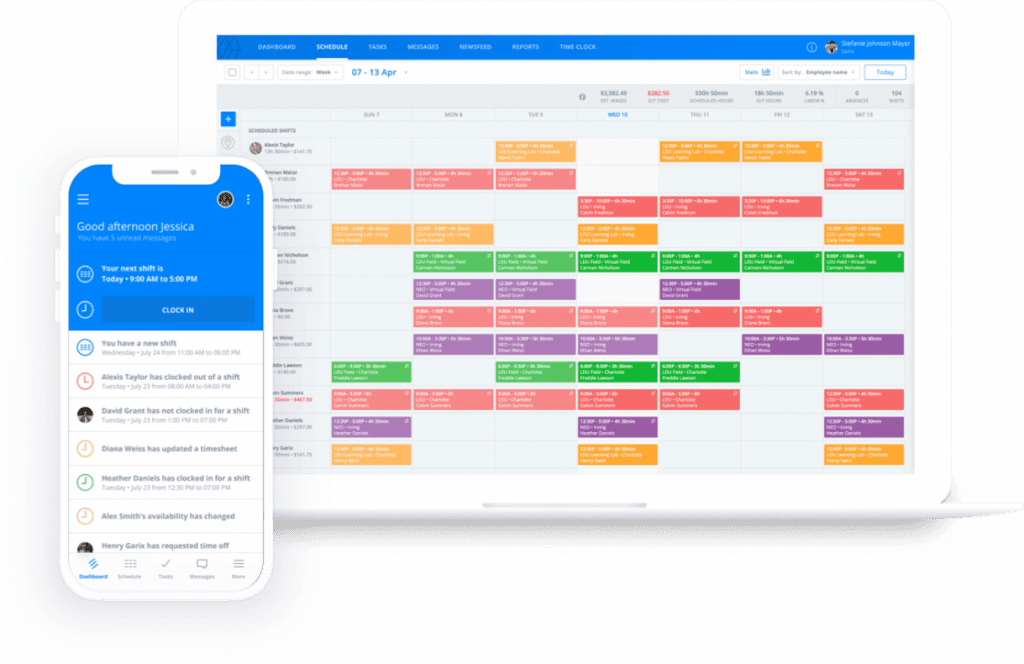Attendance Policy: How To Create The Right One For Your Business
If you run a small business, you may feel that an attendance policy is unnecessa...

Open door policies are an effective way to maintain the unity of your entire workforce and keep your business running smoothly through good times and bad. But what exactly is an open door policy, and how can you go about implementing one from scratch?
In this article, the workforce-management experts at Sling discuss the ins and outs of open door policies and offer suggestions for starting an effective program for your team.

At their most basic, open door policies mean that every employee has access to every manager for the purposes of discussing job-related issues.
This doesn’t mean that an employee who’s in the midst of the onboarding process can walk into the CFO’s office and start suggesting ways to improve the accounting structure of the business.
What it does mean is that everyone on your team — new-hire or long-timer alike — should feel comfortable going to their manager to discuss business-related issues, ask questions, and express concerns that may be weighing on their mind.
It also means that, should any of your employees feel uncomfortable discussing something with their immediate supervisor, they can approach any other manager without fear of reprimand or repercussions.
When they work correctly, open door policies promote faster communication, improved transparency, and more consistent productivity within a business structure.

Open door policies with no rules or guidelines are just a recipe for disaster. Without rules to govern the process, managers can quickly see the bulk of their day go from directing and helping drive the team forward to counseling and micromanaging each and every employee.
That’s not a good use of their time.
The first thing to do when setting up an open door policy is to establish regulations that both managers and employees abide by at all times. The best place to make these rules available is in your employee handbook so everyone can access them at any time.
Experiment with the overall process — and don’t be afraid to change it on the fly — in order to find what works best for your business.
Examples of essential rules may include:
One of the best ways to establish open door policies is to set up specific hours when supervisors are available for walk-in conversations. This helps managers carve out time for their other work and limit distractions while still being accessible to the team as a whole.
Another effective option is to schedule weekly one-on-one meetings with each team member. If the team member has nothing to report, the meeting need not continue, but if they do have an issue, the manager will have time available to deal with it.
Open door policies are only as effective as how well those in charge listen to what their employees have to say.
If an employee avails themself of the policy, practice these behaviors for a productive discussion:
It can also be beneficial to pay attention to nonverbal cues, such as facial expression, posture, eye contact, what they do with their hands, etc.
You can glean a lot about what’s going on inside their head from their behavior while they talk — even if their words don’t express how they really feel.

Dealing with problems as they come up is important, but allowing them to derail the rest of your day and affect the way your business works is not an efficient use of your time. To paraphrase a popular show biz expression: Business must go on.
To keep your business running smoothly, put a premium on time — both yours and your employees’. Try to resolve the issue the first time it comes up so that it doesn’t persist, spread, and cause more problems for your team.
This may mean getting your Human Resources Department and upper management involved, but that’s OK. Bringing in all of your resources can reduce the time and cost it takes to find a successful conclusion to the issue.
Other tips for underscoring the value of time in your policies include:
When you emphasize the value of time, the example you set will rub off on your team and influence the way they avail themselves of their managers.
To make your policies as effective as they can be, tie them into your company culture. The underlying idea behind the whole process is that it creates a more transparent and trusting employee/employer relationship.
All that, though, needs to start as a foundational element of your company mission and manifest itself as a workplace inclusivity policy that highlights the importance of everyone’s ideas, thoughts, and opinions.
Without this tie-in to company culture, your team won’t take any policy seriously and won’t see value in the idea itself.

Open door policies within your business are a powerful tool for making your employees feel valued and improving the way they work. But, more than that, regular employee feedback forges a strong employee/employer relationship.
It’s that relationship that can motivate your team to do their best even during the most difficult project. But if you don’t make communication and feedback a priority in your workflow, creating effective open door policies can be difficult.
That’s where Sling can help. Our software suite of workforce management and optimization tools makes it easy to schedule and organize every aspect of your business.
And that’s just the tip of the Sling iceberg. The Sling app also helps you:
The onboard artificial intelligence (AI) even keeps track of time-off requests, work preferences, and other employee information.
If you double-book an employee or schedule them for a time they can’t work, the Sling AI will notify you and prompt you to make the necessary change.
Regardless of the industry, Sling can help you and your team members stay organized and focused on the project at hand and keep your open door policies running smoothly all year long.
Experience the myriad ways the Sling app can improve the way your business operates by signing up for a free trial today.
For more free resources to help you manage your business better, organize and schedule your team, and track and calculate labor costs, visit GetSling.com today.
See Here For Last Updated Dates: Link
This content is for informational purposes and is not intended as legal, tax, HR, or any other professional advice. Please contact an attorney or other professional for specific advice.
Schedule faster, communicate better, get things done.